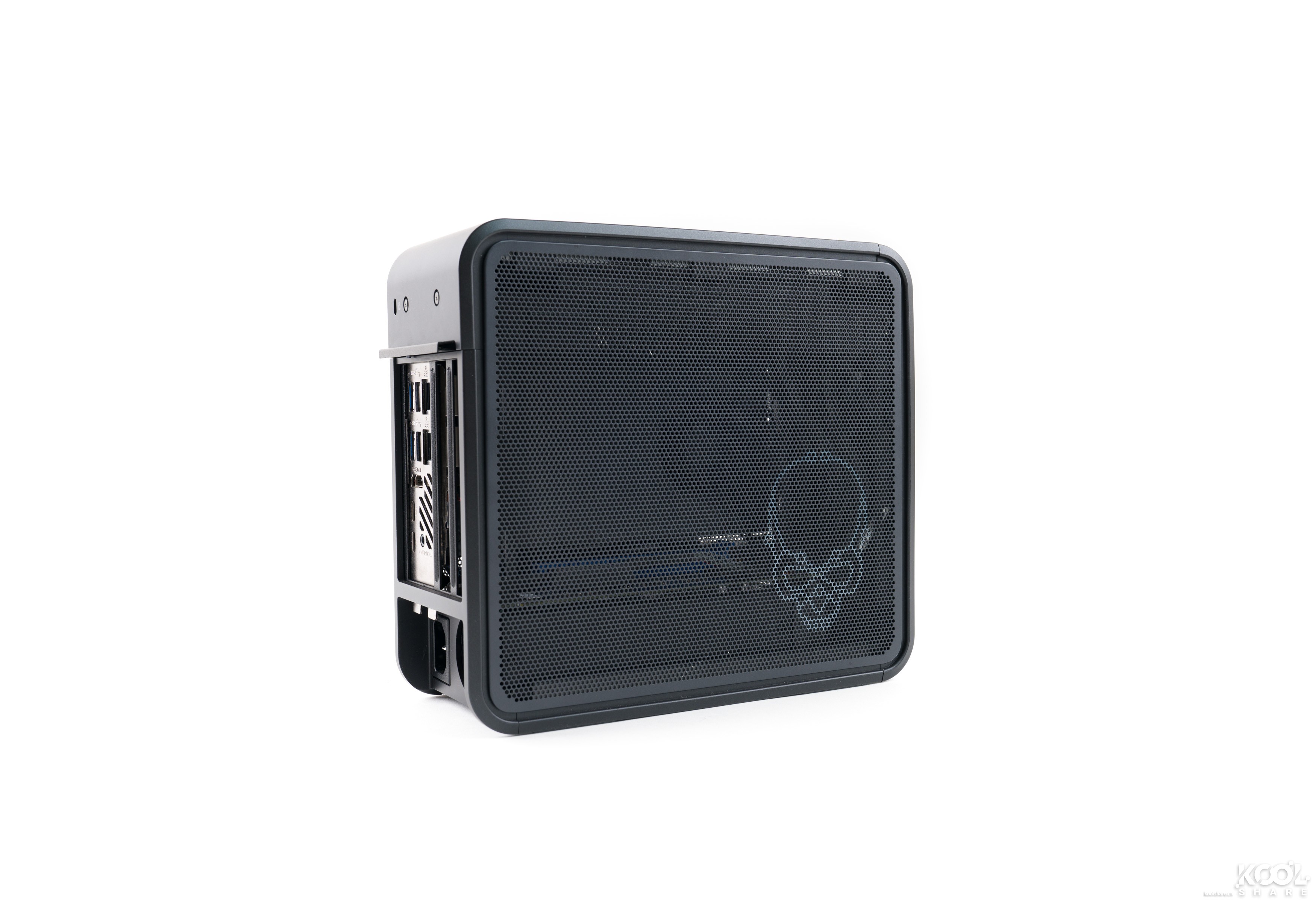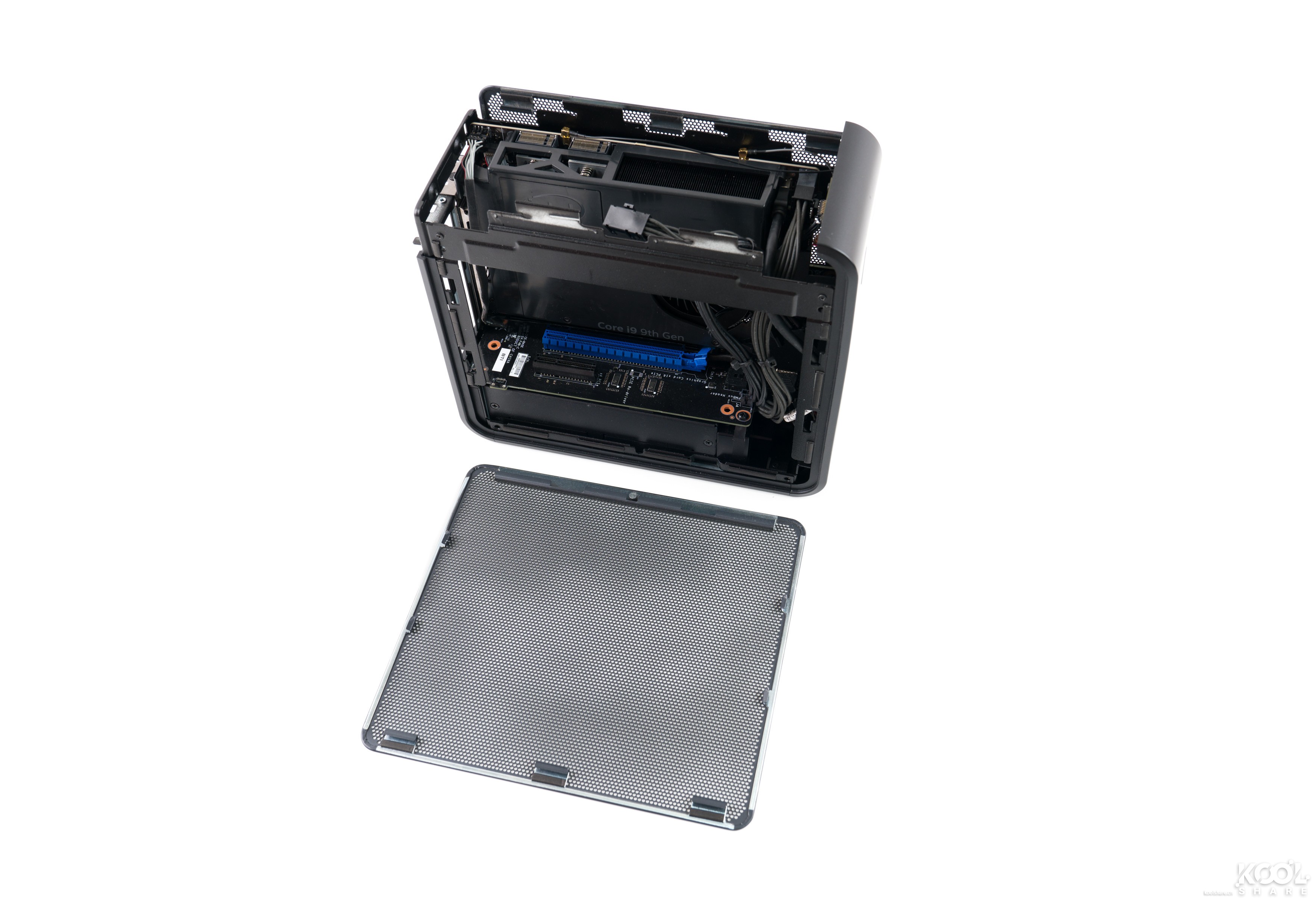Intel's 'Element' Comes To Life In Ghost Canyon NUC
A Chinese user from the KoolShare forums has reviewed and dismantled an engineering sample of Intel's upcoming NUC 9 Extreme, codenamed Ghost Canyon. It appears that the NUC (Next Unit of Computing) actually uses Intel's 'The Element' module that was revealed earlier this month.

The Intel NUC 9 Extreme measures 238 x 216 x 96mm (L x W x H) and is the chipmaker's largest NUC yet. Intel will reportedly offer three 45W processor options that span from four cores up to eight cores. You can pick between the Core i9-9980HK, Core i7-9750H and Core i5-9300H.
The NUC's front panel houses the power button, SD card reader, two USB 3.1 Gen 2 Type-A ports, and a single 3.5mm audio jack. The device features honeycomb side panels that allow fresh air to enter from both sides to cool off the internal components. Furthermore, Intel has placed a pair of 80mm cooling fans up top to expel the hot air from the NUC.

Once inside, you'll notice that the Intel NUC 9 Extreme flaunts with a new layout. The 500W power supply from FSP is located at the bottom of the NUC. A small backplane sits on top of the power supply. This backplane has two PCIe 3.0 x16 slots, one PCIe 3.0 x4 slot and a M.2 22110 slot, which has its own heatsink.
The top PCIe 3.0 x16 slot is evidently reserved for The Element module while the second PCIe 3.0 x16 slot is there for you to install a discrete graphics card. In terms of clearance, the Intel NUC 9 Extreme can accommodate dual-slot graphics cards with a maximum length of 20.32cm.

Apparently, Intel has baptized the The Element module as the "NUC Compute Element" board. For the sake of simplicity, we'll stick to the original name.
As we previously covered, The Element takes the form of a dual-slot PCIe card. It houses the processor, memory and storage devices. Besides the PCIe slot, The Element also draws power from a conventional 8-pin PCIe connector. Intel's goal with The Element is to offer a swappable and inexpensive solution for NUC owners to upgrade their systems without buying a completely new device.
Get Tom's Hardware's best news and in-depth reviews, straight to your inbox.

The processor is cooled with a passive, copper heatsink. A small cooling fan, like the kind you would typically find inside your laptop, helps with heat dissipation.
The Element comes with two SO-DIMM DDR4 slots. You can use up to 64GB of DDR4-2400 memory or 32GB of DDR4-2666 memory. It also has one M.2 2280 port and M.2 22110 port. In total, you install up to three M.2 PCIe or SATA III SSDs on the Intel NUC 9 Extreme, two inside The Element and one on the backplane. RAID 0 and 1 arrays are supported.
Connectivity on The Element includes four USB 3.1 Gen 2 Type-A ports and two Thunderbolt 3 ports. There's one HDMI 2.0a port, which is powered by the 9th-generation Core processor's integrated Intel UHD Graphics 630 solution.

The Element provides you with different options to connect to the Internet. There are two Gigabit Ethernet ports, one based of the i219-LM controller and the other from the i210-AT controller. It also has WiFi 802.11ax and Bluetooth 5 connectivity thanks to the presence of Intel's Wi-Fi 6 AX200 module.
The Intel NUC 9 Extreme seemingly comes with a limited three-year warranty. There is no word on the official pricing yet. If this leaked NUC roadmap is accurate, the NUC 9 Extreme should land next year.

Zhiye Liu is a news editor, memory reviewer, and SSD tester at Tom’s Hardware. Although he loves everything that’s hardware, he has a soft spot for CPUs, GPUs, and RAM.
-
twotwotwo The post linked from the article is a super thorough teardown/analysis and makes the design look more impressive than I thought. This is like a mini-ITX box--the reviewer stuffs a mini RTX 2060 in there and shows the machine drawing 311W power at peak--but small even for that class (5 L). Mesh sides + lots of fans help cooling, but in the stress tests it still seems to struggle w/all that heat. Guess you could compare it to the "trashcan" Mac Pro too, but more upgradeable (takes a standard 8" GPU etc.).Reply
The "compute element" idea could mainly be about Intel selling OEMs most of a NUC so they can give it their own look and marketing for different audiences. If so, good on Intel for realizing that marketing to everyone requires more than "the skull on the lid is optional." :)
I wonder if something in between this and the old high-end NUC design could have had a niche? A more-open, at-least-optionally-vertical design like this, but the old NUCs' high-TDP CPU and mobile-class dGPU (doesn't have to be glued to the CPU!) and instead of a 500W PSU taking space + giving off more heat inside the case, stick with 200ish watts from an external brick.
The higher-TDP CPU and dGPU would separate it from the tiny NUCs, open/vertical layout would make it lower-footprint and easier to cool than the old "performance" NUC, and lower-power components could make it smaller and cheaper than this new NUC. I guess the issue is maybe not that many users want an in-between machine like the old NUC (and it wasn't just a problem with its formfactor), whereas we already know there's a market for desktop boxes with desktop GPUs.